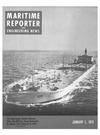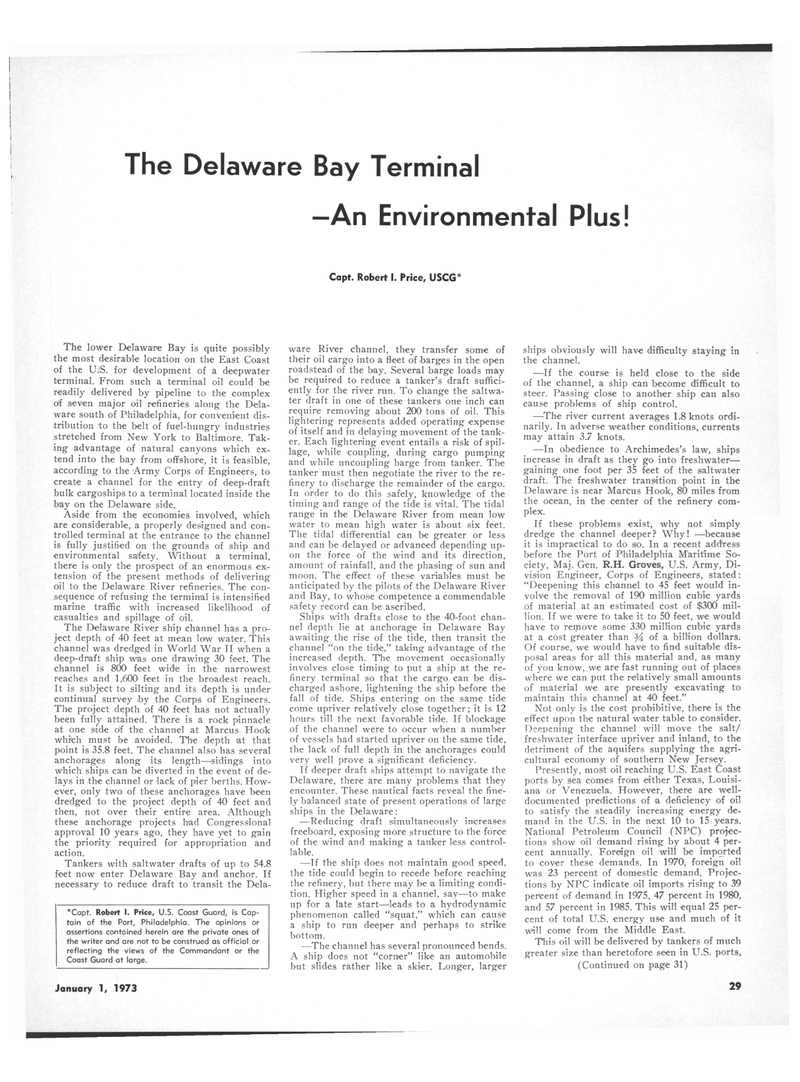
Page 27: of Maritime Reporter Magazine (January 1973)
Read this page in Pdf, Flash or Html5 edition of January 1973 Maritime Reporter Magazine
The Delaware Bay Terminal -An Environmental Plus!
Capt. Robert I. Price, USCG*
The lower Delaware Bay is quite possibly the most desirable location on the East Coast of the U.S. for development of a deepwater terminal. From such a terminal oil could be readily delivered by pipeline to the complex of seven major oil refineries along the Dela- ware south of Philadelphia, for convenient dis- tribution to the belt of fuel-hungry industries stretched from New York to Baltimore. Tak- ing advantage of natural canyons which ex- tend into the bay from offshore, it is feasible, according to the Army Corps of Engineers, to create a channel for the entry of deep-draft bulk cargoships to a terminal located inside the bay on the Delaware side.
Aside from the economies involved, which are considerable, a properly designed and con- trolled terminal at the entrance to the channel is fully justified on the grounds of ship and environmental safety. Without a terminal, there is only the prospect of an enormous ex- tension of the present methods of delivering oil to the Delaware River refineries. The con- sequence of refusing the terminal is intensified marine traffic with increased likelihood of casualties and spillage of oil.
The Delaware River ship channel has a pro-
ject depth of 40 feet at mean low water. This
channel was dredged in World War II when a
deep-draft ship was one drawing 30 feet. The
channel is 800 feet wid It is subject to silting and its depth is under
continual survey .by the Corps of Engineers.
The project depth of 40 feet has not actually
been fully attained. There is a rock pinnacle
at one side of the channel at Marcus Hook
whi'ch must be avoided. The depth at that
point is 35.8 feet. The channel also has several
anchorages along its length—sidings into
which ships can be diverted in the event of de-
lays in the channel or lack of pier berths. How-
ever, only two of these anchorages have been
dredged to the project depth of 40 feet and
then, not over their entire area. Although
these anchorage projects had Congressional
approval 10 years ago, they have y Tankers with saltwater drafts of up to 54.8
feet now enter Delaware Bay and anchor. If
necessary to reduce draft to transit the Dela-
*Capt. Robert I. Price, U.S. Coast Guard, is Cap-
tain of the Port, Philadelphia. The opinions or
assertions contained herein are the private ones of
the writer and are not to be construed as official or
reflecting the views of the Commandant or the
Coast Guard at large.
ware River channel, they transfer some of
their oil cargo into a fleet of barges in the open
roadstead of the bay. Several barge loads may
be required to reduce a tanker's draft suffici-
ently for the river run. To change the saltwa-
ter draft in one of these tankers one inch can
require removing about 200 tons of oil. This
lightering represents added operating expense
of itself and in delaying movement of the tank-
er. Each lightering event entails a risk of spil-
lage, while coupling, during cargo pumping
and while uncoupling barge from tanker. The
tanker must then negotiate the river to the re-
finery to discharge the remainder of the cargo.
In order to do this safely, knowledge of the
timing and range of the tide is vital. The tidal
range in the Delaware River from mean low
water to mean high water is about six feet.
The tidal differential can be greater or less
and can be delayed or advanced depending up-
on the force of the wind and its direction,
amount of rainfall, and the phasing of sun and
moon. The effect of these variables must be
anticipated by the pilots of the Delaware River
and Bay, to whose competence a commendable
safety record can be ascribed.
Ships With drafts close to the 40-foot chan-
nel depth lie at anchorage in Delaware Bay
awaiting the rise of the tide, then transit the
channel "on the tide," taking advantage of the
increased depth. The movement occasionally
involves close timing to put a ship at the re-
finery terminal so that the cargo can be dis-
charged ashore, lightening the ship before the
fall of tide. Ships entering on the same tide
come upriver relatively close together; it is 12
hours till the next favorable tide. If blockage
of the channel were to occur when a number
of vessels had started upriver on the same tide,
the lack of full depth in the anchorages could
very well prove a significant deficiency.
If deeper draft ships attempt to navigate the
Delaware, there are many problems that they
encounter. These nautical facts reveal the fine-
ly balanced state of present operations of large
ships in the Delaware:
—Reducing draft simultaneously increases
freeboard, exposing more structure to the force
of the wind and making a tanker less control-
lable.
—If the ship does not maintain good speed,
the tide could begin to recede before reaching
the refinery, but there may be a limiting condi-
tion. Higher speed in a channel, say—to make
up for a late start—leads to a hydrodynamic
phenomenon called "squat," which can cause
a ship to run deeper and perhaps to strike
bottom.
—The channel has several pronounced bends.
A ship does not "corner" like an automobile
but slides rather like a skier. Longer, larger
ships obviously will have difficulty staying in
the channel.
—If the course is held close to the side
of the channel, a ship can become difficult to
steer. Passing close to another ship can also
cause problems of ship control.
—The river current averages 1.8 knots ordi-
narily. In adverse weather conditions, currents
may attain 3.7 knots.
—In obedience to Archimedes's law, ships
increase in draft as they go into freshwater—
gaining one foot per 35 feet of the saltwater
draft. The freshwater transition point in the
Delaware is near Marcus Hook, 80 miles from
the ocean, in the center of the refinery com-
plex.
If these problems exist, why not simply
dredge the channel deeper? Why! —because
it is impractical to do so. In a recent address
before the Port of Philadelphia Maritime So-
ciety, Maj. Gen. R.H. Groves, U.S. Army, Di-
vision Engineer, Corps of Engineers, stated:
"Deepening this channel to 45 feet would in-
volve the removal of 190 million cubic yards
of material at an estimated cost of $300 mil-
lion. If we were to take it to 50 feet, we would
have to remove some 330 million cubic yards
at a cost greater than of a billion dollars.
Of course, we would have to find suitable dis-
posal areas for all this material and, as many
of you know, we are fast running out of places
where we can put the relatively small amounts
of material we are presently excavating to
maintain this channel at 40 feet."
Not only is the cost prohibitive, there is the
effect upon the natural water table to consider.
Deepening the channel will move the salt/
freshwater interface upriver and inland, to the
detriment of the aquifers supplying the agri-
cultural economy of southern New Jersey.
Presently, most oil reaching U.S. East Coast
ports by sea comes from either Texas, Louisi-
ana or Venezuela. However, there are well-
documented predictions of a deficiency of oil
to satisfy the steadily increasing energy de-
mand in the U.S. in the next 10 to 15 years.
National Petroleum Council (NPC) projec-
tions show oil demand rising by about 4 per-
cent annually. Foreign oil will be imported
to cover these demands. In 1970, foreign oil
was 23 percent of domestic demand. Projec-
tions by NPC indicate oil imports rising to 39
percent of demand in 1975, 47 percent in 1980,
and 57 percent in 1985. This will equal 25 per-
cent of total U.S. energy use and much of it
will come from the Middle East.
This oil will be delivered by tankers of much
greater size than heretofore seen in U.S. ports,
(Continued on page 31)
January 1, 1973 29

 26
26

 28
28
